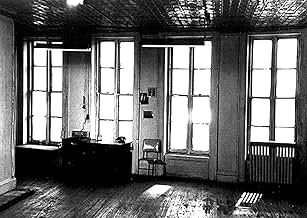अपनी भाषा में प्लॉट जोड़ेंClaimed by some to be one of the most unconventional and experimental films ever made, Wavelength is a structural film of a 45-minute long zoom in on a window over a period of a week. Very u... सभी पढ़ेंClaimed by some to be one of the most unconventional and experimental films ever made, Wavelength is a structural film of a 45-minute long zoom in on a window over a period of a week. Very unconventional and experimental, indeed.Claimed by some to be one of the most unconventional and experimental films ever made, Wavelength is a structural film of a 45-minute long zoom in on a window over a period of a week. Very unconventional and experimental, indeed.
- पुरस्कार
- कुल 1 जीत
फ़ीचर्ड समीक्षाएं
Nothing could be further from the truth, though. Good art requires that meaning be contained within the text. Events take place; people say things -- those should be the very basic requirements for art. The tools of cinema -- editing, camera placement and movement, and so forth -- are important, but alone, don't cut it. A mere, 'cool' concept doesn't suffice. So skip the earth-shattering, condescending, pretension of Wavelength -- and its musical analogue in the "compositions" (I use that phrase lightly) of John Cage -- and instead look elsewhere, in films and works that seek to communicate real ideas about human experience. If you do feel a need to profess a real knowledge of "art," watch Bergman's "Wild Strawberries," or Fellini's "8 1/2." Heck, rent "E.T." for goodness sake. But please don't be fooled by by this junk.
At a little under 45 minutes long, Wavelength is not an easy film to get through. It features a non-moving camera set in a large room, and nothing else. The camera captured the action that goes on in the room to create what Snow calls "a summation of my nervous system, religious inklings and aesthetic ideas." On the surface it is merely a stiff frame of three walls, a floor and a ceiling with the occasional, but brief, interaction of a human variety. But once you look closer you will realize that your eyes have deceived you.
Through the entire film, Snow has his camera zooming in at an extremely slow speed. After realizing this, your eyes will be fixated on the screen in a desperate attempt to convince yourself that you are not insane. I found the entire concept to be so emotionally exhausting and frustrating that once the film was over I could do nothing but watch it again. It was a pleasantly unpleasing experience that did nothing but expand my conception of conventional filmmaking.
I have to admit that the soundtrack behind the film was a bit confusing for me. It was nonexistent for most of the film, but all of a sudden WHAM! Imagine the most ear-piercing scream or squeal that you have ever heard. Now combine them to make the last half an hour of Wavelength. I honestly thought that I was going to disturb my neighbor's dog with the high pitched whistles and unexplainable wails that accompanied the actionless action. If you can handle the sounds you will be rewarded by the film.
With Wavelength, Snow created the most aesthetically praised work in all of avant-garde. His technique ultimately forced me into a starring contest with the screen. It was me versus the structure of a single room. It was me versus the nonexistent, but ever present, movement of the camera's lenses. I waited arrogantly for the film to flinch. It never did. And then it ended.
Yet it holds value to many others in its artistic nature. Sadly as I failed to consciously view most of it I can only give short and brief opinion on it as a good sleep aid.
Like Hollis Frampton's ZORNS LEMMA, WAVELENGTH is the kind of picture made to be written about, not really endured. The glowing descriptions of it in critics' prose are more provoking than the actual artifact itself. Two things remain striking and puzzling about it thirty-two years later. Why did Snow choose to make a near-hour-long demonstration of the zoom lens? Why would tracking have been any different--is the movie meant to be a statement on a subjective appearance of changed perspective, while the viewer really remains static? Or was Snow just infatuated with the gimmickry of the zoom? (Each calibration churning closer to the photograph has a home-movie clunkiness.)
The other is the oddly hippie-dippie tone of Snow's inserted gimcrackery. From the charwoman-looking extra playing "Strawberry Fields Forever" on a radio, then lumbering off like a bit player in an Ed Wood number, to the acid-flashback reruns of just-passed scenes, to the freak colorizations of arbitrary moments (as if we jumped to the POV of a UFO), the ambience is much more Big Brother and the Holding Company than Robert Bresson. It's the same playing-with-a-gizmo amateurism that mars the images using people in Stan Brakhage's DOG STAR MAN, and it makes Snow's academic astringency look like a pose.
(WAVELENGTH showed up again, ripped off in the unlikeliest place: the track into a photograph that forms the "Twilight Zone" epilogue to Kubrick's THE SHINING.)
क्या आपको पता है
- ट्रिवियाMichael Snow has stated that his intent with the film was for it to be "a summation of my nervous system, religious inklings and aesthetic ideas."
- भाव
Woman in fur coat: I just got here, and there's a man lying on the floor, and I think he's dead.
- कनेक्शनEdited into WVLNT: Wavelength For Those Who Don't Have The Time (2003)
टॉप पसंद
विवरण
- चलने की अवधि45 मिनट
- रंग
- पक्ष अनुपात
- 1.37 : 1
इस पेज में योगदान दें


















